Strawberries
Organic Strawberry Summit
A meeting concerning a phase in of organically produced and certified plant stock (i.e. transplants) in strawberries will take place at the UC Cooperative Extension office at 1432 Freedom Blvd in Watsonville this coming Wednesday, March 20. The discussion will concern the use of plug plants, a presentation by a producer in the past of organically certified transplants, a clarification of organic plant stock guidance by the USDA and a discussion about anaerobic soil disinfestation work to be done at the nursery level.
The agenda for the meeting is attached can be found at:
http://cesantacruz.ucanr.edu/files/163353.pdf
A Treatise on Powdery Mildew in Strawberry
Introduction: This blog post is about the very common fungal pathogen of strawberry, powdery mildew. What follows is a review on the biology and management of this disease.
Causal Organism: Powdery mildew is caused by the pathogen that historically has been named Sphaerotheca macularis f. sp. fragariae. However, future scientific publications and other writings will likely use the new name Podosphaera aphanis. Like most powdery mildew pathogens on other hosts, the majority of the mycelium of this fungus grows on the outside of strawberry leaves and fruit. The masses of mycelium produce spores (conidia) that form in chains, are barrel shaped, whitish to clear (hyaline), and dry (Photo 1). If your vision is sharp, you could be able to see the spores with the unaided eye since powdery mildew conidia are relatively large compared to spores of other fungi. With a hand lens or dissecting microscope, chains of powdery mildew conidia are readily seen.
Symptoms: Powdery mildew appears as white patches of fluffy mycelium tending to infect the undersides of younger leaves first. If conditions favor the fungus, then the disease advances onto the top sides of these leaves; in severe cases, powdery mildew moves onto older leaves, petioles, flowers, and fruit. It is important not to confuse these initial, small white patches of mildew with the waxy white deposits produced by whiteflies during egg laying (Photo 2 and 3). Mildew infections eventually result in an upward curling of infected leaves. On some cultivars, such as Camarosa, a brown to purple blotchy discoloration forms on the upper leaf surface (Photo 4) . Mildew infections of immature fruit result in a small, unripened fruit. Powdery mildew infections of mature fruit are more obvious due to the white mycelial growth on the surface and the protruding seeds (Photo 6); if such fruit are eaten they can have a distinctive moldy taste.
Disease Cycle: It is believed that in California the majority of powdery mildew inoculum infecting first year strawberry plantings comes from the leaves or crowns of transplants. Such transplants are either carrying inoculum on them from the nursery or are already infected prior to being dug. In addition, second year or volunteer strawberries in the vicinity are likely to be infected with powdery mildew; these established plants provide a second source of spore inoculum that is carried by winds to new plantings. The powdery mildew fungus produces overwintering, sexual structures called chasmothecia (previously these were called cleistothecia) but these do not commonly form on strawberry grown in California and therefore do not appear to have an important role in disease development.
Epidemiology: Powdery mildew has certain conditions in which it thrives. A range of temperatures from 60o to 80o (15o to 26.7o C) during periods of moderate to high humidity (think fog) are the conditions which are optimum for powdery mildew growth. In addition, the fungus actually does not grow well if leaves are wet with free moisture. So the fungus develops more readily if strawberry foliage is dry.
Management: As fully as possible, an integrated pest management (IPM) approach is suggested when it comes to controlling any strawberry disease. Fungicides are a key IPM component for minimizing powdery mildew infection in strawberries on the Central Coast of California. There is a wide selection of fungicides available for use on strawberry (http://www.ipm.ucdavis.edu/PMG/r734100711.html). Examples of such products are myclobutanil (Rally), triflumazol (Procure), pyraclostrobin + boscalid (Pristine) and quinoxyfen (Quintec). There are concerns of reduced sensitivity of the pathogen to several classes of these fungicides, but there is no hard evidence of resistance to any of them to date. It is worth noting that there are no reports of reduced efficacy of sulfur (both as a dust and flowable) despite the many years it has been used against powdery mildew. Many horticultural oils and insecticidal soaps (for example M-Pede) can also be effective for powdery mildew when applied at a frequency of every 10 to 14 days, but it should be pointed out that frequent applications of these oils or soaps can stress strawberries and reduce plant productivity while also reducing mildew.
To maximize the efficacy of fungicides used, one should begin applying these materials at the first sign of disease, which on the Central Coast can be as early as February or March and continue as favorable conditions for mildew growth continue.
Since a large portion of the powdery mildew initially infecting strawberry fields comes from the transplants, growers should make sure they are receiving clean plants. It is standard practice in the California strawberry nursery industry to apply a high number of protectant treatments for powdery mildew, but growers concerned about powdery mildew coming from nursery plants are encouraged to check with their provider to understand mildew management practices.
Genetic resistance to fungal diseases is an important aspect of disease management. While there is no complete resistance to powdery mildew in strawberry, there is still a wide range of susceptibility to the disease among the varieties grown in California, a discussion which is beyond the scope of this post. Growers are well advised to be aware of the relative susceptibility for disease in the varieties they are planting, especially if growing in an area known to be problematic for powdery mildew. Also, growers should perhaps avoid planting a very susceptible cultivar adjacent to a second year strawberry field.
The above has been a discussion the biology and management of powdery mildew disease in strawberry. There are pesticides mentioned for the management of powdery mildew on strawberry in this article. Before using any of these products, check with your local Agricultural Commissioner’s office and consult product labels for current status of product registration, restrictions and use information.
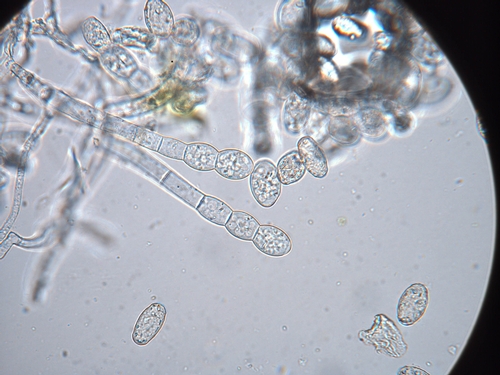
Photo 1: View of the powdery mildew pathogen under the microscope. Photo courtesy Steven Koike.
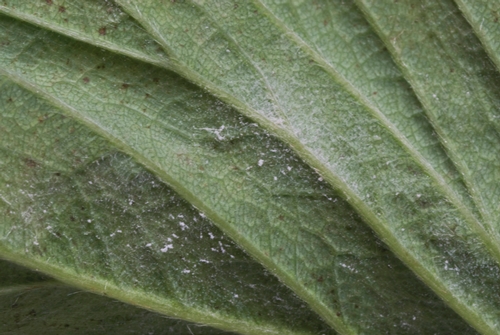
Photo 2: Close up of powdery mildew on a strawberry leaf. Photo courtesy of Steven Koike.
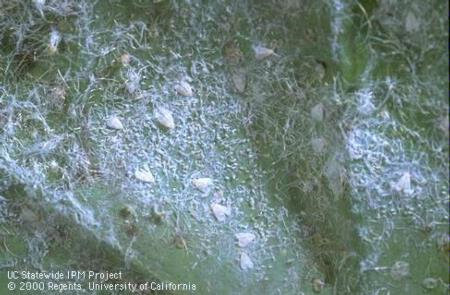
Photo 3: Waxy material in association with whitefly eggs. Please do not confuse these with powdery mildew.
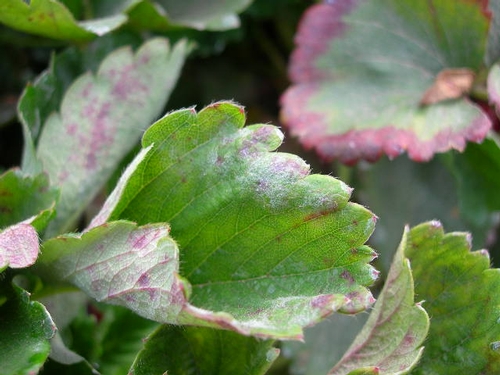
Photo 4: Powdery mildew on leaf of 'Camarosa' variety strawberry. Note the leaf curling and association with purple blotches. Photo by Mark Bolda.
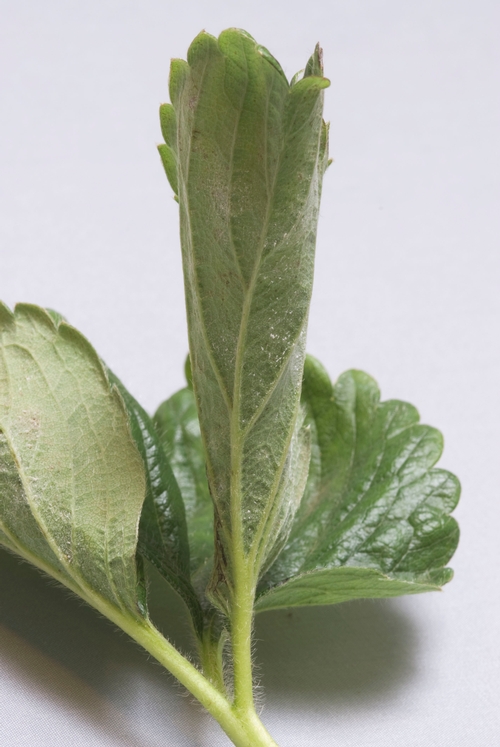
Photo 5: Powdery mildew on young strawberry leaf. Photo courtesy Steven Koike.
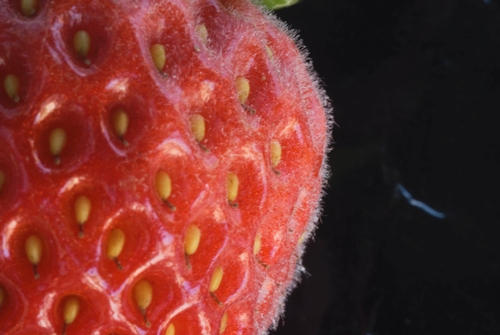
Photo 6: Side view of powdery mildew on strawberry fruit. Photo courtesy Steven Koike.
Field efficacy of the experimental insecticides sulfoxaflor, tolfenpyrad and flonicamid for lygus bugs in strawberry.
Introduction: As noted previously in this blog, lygus bugs are a major pest in strawberries since they cause mis-shaping of fruit from their feeding on the early forming fruit. This pest has been a real challenge to California strawberry growers, one reason being that the populations in the Central Coast production regions have become quite tolerant or even resistant to many of the pesticides used for it.
Fortunately several promising insecticide chemistries for control of lygus bugs have become available for field trials over the past few years.
Please note that sulfoxaflor and tolfenpyrad are still NOT REGISTERED (flonicamid is) for use in strawberries.
Three large scale trials of up to a third of an acre per treatment were conducted this past year to test these three novel insecticides under real field conditions.
Application: One trial in a second year strawberry field in Salinas testing three materials (plus one grower standard) was conducted with a standard research backpack sprayer (applied 5/3/2012), another (overseen by the California Strawberry Commission) in a first year field in Guadalupe with a tractor mounted spray rig (applied 8/28/2012 and 9/12/2012), and a third in Watsonville with another tractor mounted spray rig (applied 10/5/2012 and 10/12/2012). Refer to the table below for rates of test material and water carrier.
|
Test Material (Brand Name) |
Trial 1 Salinas |
Trial 2 Guadalupe |
Trial 3 Watsonville |
|||
|
|
Water carrier Rate |
Test material Rate (formulated product) |
Water carrier Rate |
Test material Rate (formulated product)1 |
Water carrier Rate |
Test material Rate (formulated product)1 |
|
Untreated Control |
- |
- |
- |
- |
- |
- |
|
Sulfoxaflor (Closer) |
75 gal/A |
5.7 fl oz/A |
100 gal/A |
5.7 fl oz/A |
200 gal/A |
5.7 fl oz/A |
|
Tolfenpyrad (Bexar) |
75 gal/A |
27 fl oz/A |
100 gal/A |
27 fl oz/A |
200 gal/A |
27 fl oz/A |
|
Flonicamid (Beleaf) |
75 gal/A |
6.0 fl oz/A |
- |
- |
- |
- |
|
Malathion Aquamul |
75 gal/A |
2 pt/A |
- |
- |
- |
- |
1 Note that these materials were added with the surfactant Natural Wet at the rate of 8 fl oz/A.
Insect and Fruit Sampling: Lygus bugs were sampled by beating 20 strawberry plants (3 times each) in a row into an open plastic container and counting small nymphs, large nymphs and adults. Lygus bugs were sampled weekly for 6 weeks following the first spray application in Guadalupe, weekly for three weeks following the first application in Watsonville and weekly for four weeks following the application in Salinas. Fruit evaluation took place on 9/26/2012 and 10/10/2012 in Guadalupe and 10/19/2012 and 10/26/2012 in Watsonville. Fruit sampling consisted of randomly picking 50 fruit from the center two furrows of each trial. These picked fruit were graded into three categories; marketable, unmarketable due to lygus feeding (“catfacing”) and unmarketable due to other causes (mainly rots and small size).
Statistical analysis is a standard analysis of variance (ANOVA), using a square root or a logarithmic transformation in some instances in order to closer meet the assumptions of the statistical analysis .
Results and Discussion:The experimental sprays worked, especially the sulfoxaflor. Analysis by date show that sulfoxaflor treated plots in the Guadalupe and Watsonville trial were associated with lower numbers of adults, large nymphs and small nymphs on multiple dates after the initial application, and treated plots in Watsonville. Tolfenpyrad also did result in significant reduction in numbers of nymphs and adults on certain evaluation dates, particularly two weeks after the first application.
See Graphics 2-4 below for visual demonstration of evaluation results of lygus nymphs and adults 14 days after first pesticide application at each trial site.
The use of sulfoxaflor resulted in significantly higher amounts of marketable fruit than the untreated control on three sampling dates at both evaluation sites, while the use of tolfenpyrad resulted in significantly higher amounts of marketable fruit than the untreated control on two sampling dates at the trial site in Watsonville. Refer to Table 1 below for a summary of these results.
Table 1: Average marketable fruit yield for each sampling pick date for insecticide trials in Guadalupe and Watsonville, CA
|
Guadalupe |
||
|
Date |
Test Material |
Avg Marketable Fruit (out of 50)* |
|
9/26/2012 |
Sulfoxaflor (Closer) |
26.50 A |
|
|
Tolfenpyrad(Bexar) |
11.75 B |
|
|
Untreated |
8.25 C |
|
10/10/2012 |
Sulfoxaflor (Closer) |
14.50 A |
|
|
Tolfenpyrad(Bexar) |
3.25 B |
|
|
Untreated |
0.75 B |
|
Watsonville |
||
|
Date |
Test Material |
Avg Marketable Fruit (out of 50)* |
|
10/19/2012 |
Sulfoxaflor (Closer) |
14.50 A |
|
|
Tolfenpyrad(Bexar) |
10.50 B |
|
|
Untreated |
6.00 C |
|
10/26/2012 |
Sulfoxaflor (Closer) |
21.50 |
|
|
Tolfenpyrad(Bexar) |
27.25 |
|
|
Untreated |
25.00 |
*Letters indicate significant differences by post hoc analysis at p<0.05
Outside of malathion and flonicamid, the sulfoxaflor and tolfenpyrad are still NOT REGISTERED for use in strawberries. Before using any insecticide products, check with your local Agricultural Commissioner's Office and consult product labels for current status of product registration, restrictions, and use information.
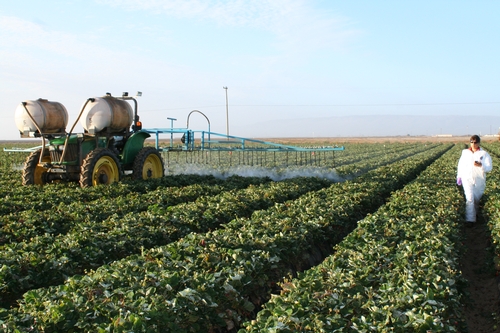
Dr. Thomas confirming correct tractor speed for an experimental lygus insecticide application.
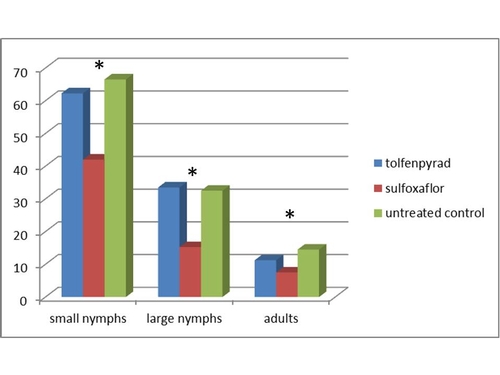
Graphic 2: Results 14 days after first application of experimental insecticide for lygus in Guadalupe 2012. *Indicates treatment was significantly lower than the untreated control.
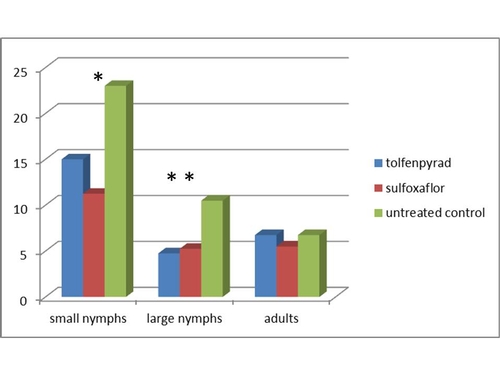
Graphic 3: Results 14 days after first application of experimental insecticide for lygus in Watsonville 2012. *Indicates treatment was significantly lower than the untreated control.
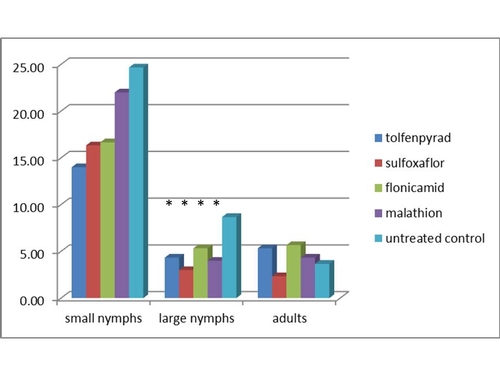
Graphic 4: Results 14 days after first application of experimental insecticide for lygus in Salinas 2012. *Indicates treatment was significantly lower than the untreated control.
A Reminder About Light Brown Apple Management in the Pajaro Valley for 2013
Strawberry and caneberry growers should be reminded that the CDFA-USDA regulatory program for light brown apple moth is still regnant in Santa Cruz and north Monterey counties this year and we should all be taking steps to reduce numbers of this pest in the production fields. I communicated with Rick McKay, head of the USDA-APHIS regulatory effort for this area, and he assured me the program will be active again in 2013 in the same way it was active last year, at least until September 30.
Pheromone based twist ties are a good way to reduce LBAM numbers in fields, especially in raspberries and blackberries since the ties are attached to the trellis with very little effort and time. The twist ties are still available through the Santa Cruz County Agricultural Commissioner at 763-8080. There are still quite a few left, and a quick call to the distributor Pacific Biocontrol Corporation reassured me that these ties, which were received in 2010, are still viable since they are being stored in a cooler and are in their original packaging. These twist ties cost nothing and give growers a good measure of protection against LBAM infestation and the accompanying regulation.
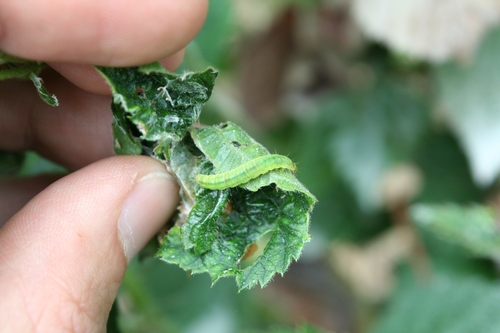
Bane of the berry industry in the 2010's: a leafroller.
Presentations from February 5 Strawberry Meeting Now Posted
For those who may have missed the February 5 Annual Strawberry Production Research meeting, the Powerpoints of most of the presentations are now available on our county website. The presentations will be found just under the Current News link:
http://cesantacruz.ucdavis.edu/

